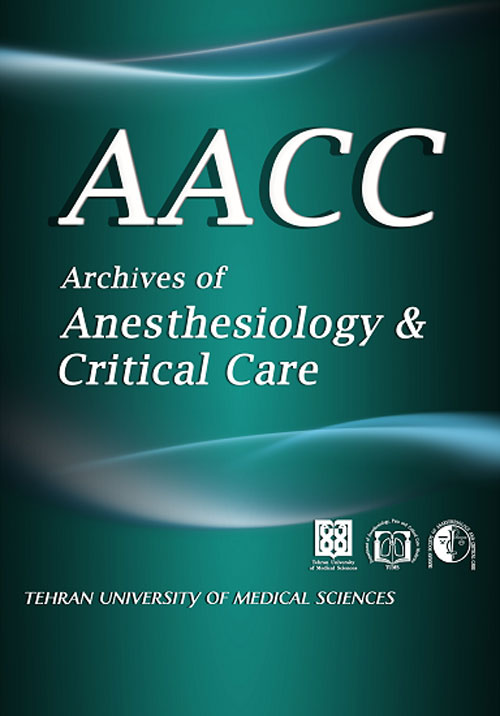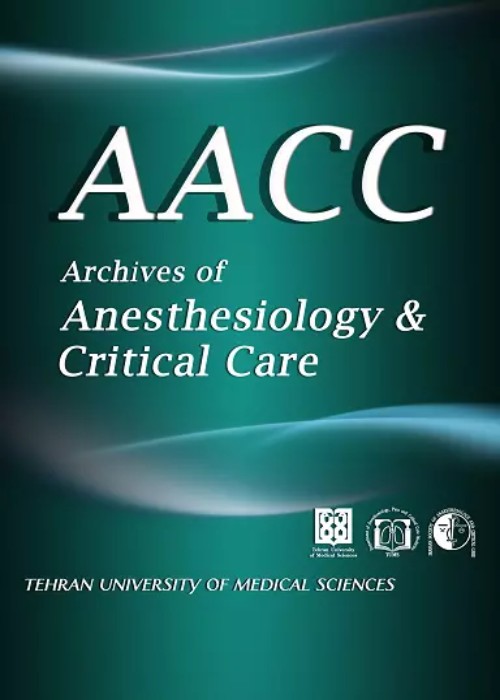فهرست مطالب

Archives of Anesthesiology and Critical Care
Volume:6 Issue: 2, Spring 2020
- تاریخ انتشار: 1399/03/22
- تعداد عناوین: 9
-
-
Pages 58-59
The information technology (IT) industry is paving its path into modern health care and nothing can stop it.
Keywords: Health care, Information technology, Medical education -
Pages 60-64Background
The use of subcutaneous enoxaparin is a usual method for preventing venous thromboembolism (VTE) in the intensive care unit (ICU) patients, but adequate absorption of the drug is not reliable due to the illness intensity, existing edema and hypoperfusion in these patients. The aim of this study was to compare the effect of intravenous enoxaparin with subcutaneous enoxaparin to prevent VTE in ICU patients.
MethodsThe current double-blind Randomized clinical trial was performed on 64 patients admitted to the ICU at Khatam- Al- Anbia Hospital in Zahedan, southeast of Iran. The patients were randomly assigned into each of the subcutaneous enoxaparin and the intravenous enoxaparin groups. The blood sampling was performed aseptically and then active factor Xa level was measured. Next, the intervention group received 0.5 mg/kg of intravenous enoxaparin for 10 days and the control group was injected subcutaneously the same dosage of drug. Four hours after the first injection and 12 hours after the last injection on the tenth day, the factor Xa level and the frequency of VTE incidence was measured again.
ResultsIn all three measurement times, the active factor Xa level in the intravenous enoxaparin group was lower than that of the subcutaneous group, but no significant difference was observed between the two groups and different times (P> 0.05).
ConclusionThe results of this study showed that the use of intravenous enoxaparin is an effective way to prevent the VTE development in the ICU patients.
Keywords: Enoxaparin, Venous thromboembolism, Active coagulation factor X -
Pages 65-70Background
Videolaryngoscopes are now being advocated as the universal device for airway management due to their ability to provide an improved glottic visualisation. Due to their ability to see around the corners, they obviate the need to align the airway axes and thus may lead to less airway stimulation. This may result in less haemodynamic response during laryngoscopy and intubation. The present study was designed to compare the haemodynamic response to intubation with King Vision and C-MAC® videolaryngoscopes.
MethodsAfter obtaining informed consent, adults with unanticipated difficult intubation, scheduled to undergo surgery under general anaesthesia were randomised to be intubated with either King Vision (Group K) or C-MAC® (Group C) videolaryngoscope. Following a standardised general anaesthesia induction protocol all subjects were intubated with the allocated videolaryngoscope and haemodynamic parameters (heart rate, systolic pressure, diastolic pressure and mean arterial pressure) were recorded at specific time points. Statistical analysis was done using the SPSS Software (version 18.0).
ResultsThe changes in the heart rate, systolic pressure, diastolic pressure and mean arterial pressure following laryngoscopy and intubation with the allocated videolaryngoscope were statistically similar between the two groups at all time points.
ConclusionHaemodynamic responses to laryngoscopy and intubation with King Vision and C-MAC® videolaryngoscopes were similar.
Keywords: KingVision, C-MAC, Videolaryngosocpe, Haemodynamic response -
Pages 71-77Background
Two major complications of surgeries are postoperative nausea and vomiting (PONV) and also postoperative pain (POP). Several studies have compared total intravenous anesthesia (TIVA) with inhalational anesthesia regarding these two complications. Some results have shown a better postoperative recovery conditions, but other contradictory results can also be found.This study was performed to evaluate and compare the effect of inhalational and intravenous anesthesia in patients undergoing elective laparoscopic surgery, on the incidence and the severity of PONV and POP.
MethodsThis study was performed as a single-blinded prospective clinical trial. All patients aged 18-65, with ASA class I and II who underwent elective laparoscopy were included. Patients were divided into two groups of intravenous anesthesia and inhalational anesthesia. The incidence and the severity of PONV and POP were examined in 5 separated times after the surgery. The use of a rescue antiemetic and analgesic medication were also evaluated.
ResultsOverall, 67 patients received inhalational anesthesia and 55 patients received intravenous anesthesia. It was revealed that 47.8% of the patients in the inhalation group and 18.2% of the patients in the intravenous group developed PONV (P<0.001). The severity of PONV was significantly lower in the TIVA group (P<0.001), however, no statistically significant difference was found regarding the severity of abdominal pain (P=0.62).
ConclusionThe incidence of PONV and the need for administration of an antiemetic rescue drug are significantly lower in the TIVA group.
Keywords: Postoperative nausea, vomiting, Postoperative pain, Inhalation anesthesia, Intravenous anesthesia, Laparoscopy -
Pages 78-82Background
Goal-directed fluid therapy may improve perioperative fluid management. This study aimed to evaluate the effects of Pleth variability index (PVI)-guided fluid therapy on changes in intraoperative serum lactate levels in comparison with liberal fluid therapy.
MethodsThis study was a randomized double-blinded clinical trial that was conducted in the operating room of a university hospital. Inclusion criteria comprised patients aged 18–60 years and classified as American Society of Anesthesiologists physical status class I and II, who were candidates for elective thyroidectomy. In total, 44 patients meeting the inclusion criteria were enrolled in the study and randomly assigned to two groups: the liberal and PVI groups. In both groups, 5 mL/kg bolus of normal saline was infused prior to the anesthesia induction. In the PVI group, 100 mL bolus of normal saline was administered every 5 min if the PVI remained >13% during the operation. In the liberal group, continuous crystalloid infusion (5–6 mL/kg/h) was administered throughout the surgery. Arterial blood samples were taken, and serum lactate levels were measured following anesthesia induction and just before tracheal extubation.
ResultsIn the PVI group, mean serum lactate decreased at the end of the surgery, with a difference of −0.6 ± 0.13 mmol/L, whereas it increased in the liberal group (0.070 ± 0.3, P<0.05).
ConclusionIn conclusion, we found that using intraoperative PVI-guided fluid therapy could decrease serum lactate levels and total fluid administration compared to the liberal method.
Keywords: Perioperative care, Fluid therapy, Pleth variability index, Serum lactate -
Pages 83-88Background
For patients with prolonged bed rest and immobilization because of motor or consciousness disorders, many factors may contribute to the development of pressure ulcers. To this end, the present study aimed to investigate the frequency of pressure ulcers and the factors affecting the development of this condition in intensive care units (ICUs).
MethodsIn this descriptive cross-sectional study, the case files and records of patients hospitalized between March 2017 and March 2018 entered the study using the census method. The necessary information including age, gender, location of pressure ulcers, number of ulcers on each part of the body, length of stay in ICU, and underlying diseases was extracted from the files and recorded in the data checklist. In the end, the extracted data were analyzed with SPSS 25.
ResultsOf the 781 patients studied, 71 (9.1%) had pressure ulcers, of whom 34 were men and 37 were women. A statistically significant difference was found between men and women in terms of the incidence of pressure ulcer (p = 0.0013). The most common sites of pressure ulcers were buttock with 34 cases (47.9%) and sacrum with 21 cases (29.6%).
ConclusionOld age and prolonged stay in ICU are important determinants of the development of pressure ulcers.
Keywords: Pressure ulcer, Bedsore, Intensive care unit -
Pages 89-102
Acute cardiogenic pulmonary edema (ACPE) is a common and life-threatening condition among patients with heart failure. The literature contains a large number of reviews discussing the respiratory management aspect of this entity; nonetheless, none of these studies has thoroughly probed into the respiratory management of different cardiac pathologies ending with ACPE, together with the different modes of ventilation and invasive and noninvasive ventilation in the same discussion. The present review seeks to discuss the physiologic bases of lung-heart interactions, the hemodynamic effects of positive pressure ventilation, and the results of studies on the effects of the various modes of ventilation having been used until the writing of this article. Also discussed herein are ACPE in different heart pathologies and their respective ventilator management, as well as the indications, complications, and contraindications of noninvasive positive pressure ventilation and intermittent mandatory ventilation.
Keywords: Acute cardiogenic pulmonary edema, Critical care, Ventilation, Respiratory management -
Pages 103-104
Pain experienced after a stroke is one of the worst experience for a given patient. Post stroke pain can present in various forms of which central post stroke pain (CPSP) is a neuropathic pain involving the area affected during the stroke. Till date there were different classes of medication used to treat CPSP without any promising results. This indirectly indicates so many mechanisms were included in these patients resulting in pain. We would like report a case of CPSP successfully treated in our institute with low dose lignocaine injection peripherally. We would like to conclude that the afferent sensory input from the painful area plays a role in maintaining the spontaneous (and the evoked) pain in CPSP which are getting blocked by giving low dose lignocaine injection peripherally. Further studies will be required to establish this novel treatment.
Keywords: Central post-stroke pain, Low dose lignocaine, Neuropathic pain -
Pages 105-108
During electrical accidents, various mechanisms are observed: electric flash, electric arc, lightning and true electrification. Whatever the mechanism, various types of lesions can be observed such as subarachnoid hemorrhages. Exposure to a high voltage current, the appearance of initial consciousness disorder, the existence of skin burn lesions testifying to the passage of current through the cephalic end homolateral to the hemorrhage, the existence of hemorrhage meningeal at d0, the real existence of this complication in victims of lightning strikes (which is an electric shock) and the existence of a similar case in the literature make electric accidents, an etiology of hemorrhage meningeal.
Keywords: Electrification, Haemorrhage, Meningeal, Resuscitation


